Utilization of By-Product of Groundnut Oil Processing for Production of Prodigiosin by Microbial Fermentation and Its Novel Potent Anti-Nematodes Effect
Abstract
:1. Introduction
2. Materials and Methods
2.1. Establishment of Small Scale Production of PG in Flasks
- ▪
- Methods for determination of nutrient content of GNC: Some major nutrient ingredients of GNC were determined, including total protein [32], total mineral ash [32], mineral elements (by the generation 5 phenom pro and proX SEMs). Content of specific minerals including potassium, magnesium, calcium, and phosphorus was determined by the AA-7000 atomic absorption spectrophotometer (AAS) and spectrophotometric methods for phosphorus [33], total lipids [34], total dissolved sugar [35], and reducing sugar [36].
- ▪
- Screening potential PG-producing bacterial strain: Several strains of S. marcescens obtained from our previous studies including TKU011, TNU01, TNU02, and CC17 [2,5,25,27] were conducted for the tests. Liquid medium containing 1.5% GNC, 0.5% casein, 0.1% K2HPO4, 0.05% MgSO4‧7H2O at initial pH 7.0 was fermented by these four bacterial strains at 28 °C, 150 rpm (shaking speed) for two days. The fermentation condition was symbolized as (*) to be further used for some experiments. S. marcescens TNU02 was chosen as a PG-producing strain for further experiments.
- ▪
- The effect of supplementary ingredients and GNC concentration on PG production:
- -
- Effect of vegetable oils on PG production: various vegetable oils including olive oil (OLO), groundnut oil (PNO), brown rice oil (BRO), soybean oil (SBO), coconut oil (CCO), and sesame oil (SSO) were supplemented into the liquid medium containing 1.5% GNC, 0.5% casein, 0.1% K2HPO4, 0.05% MgSO4‧7H2O at the initial pH 7.0. Thirty milliliters of these experimental media and the control medium (no supplementary oils) were fermented by S. marcescens TNU02 strain at the above-mentioned conditions (*).
- -
- The effect of free protein on PG production: Casein was confirmed as a suitable free protein for enhancing PG production [25]. Thus, casein was added to the culture medium in this study. GNC was mixed with this protein in several ratios of 10/0; 9/1; 8/2; 7/3; 6/4; 5/5 and used as the major C/N source for fermentation. The culture medium was supplemented with 0.1% K2HPO4, 0.05% MgSO4‧7H2O, and an initial pH at 7.0, then fermented by the TNU02 strain under the above-mentioned conditions (*).
- -
- The effect of GNC concentration on PG production: GNC was used as the sole C/N source for fermentation. Several concentrations of GNC (0.25, 0.5, 0.75, 1, 1.25, 1.5%) was added into the liquid solution containing 0.1% K2HPO4, 0.05% MgSO4‧7H2O with an initial pH 7.0. then fermented by TNU02 strain under the above-mentioned conditions (*).
- ▪
- The effect of salts on PG production: This experiment was designed based on previous studies [25,26]. Five types of sulfate salts including (NH4)2SO4, K2SO4, FeSO4, ZnSO4, and MgSO4 (at 0.05%) were added into the medium containing 1% GNC, 0.1% K2HPO4 at an initial pH at 7.0, and fermented by TNU02 strain under the above-mentioned conditions (*). Moreover, five types of phosphate salts including K2HPO4, KH2PO4, NaH2PO4, Na2HPO4, and Ca3(PO4)2 at 0.1% concentration were also added into the medium containing 1% GNC, 0.05% MgSO4‧7H2O with the initial pH at 7.0, then fermented by TNU02 strain under the above-mentioned conditions (*) for investigation of their effect on PG production.
2.2. Scale-Up of PG Production to a 14 L-Bioreactor System and Extraction of PG from the Culture Broth
2.3. Method of Quantification, Purification, and Identification of PG
2.4. Anti-Nematode Assays
- -
- Eggs and J2 root-knot nematodes preparation: eggs and J2 nematodes were prepared according to the method previously presented by Khan et al., 2008 [37] with some modifications. Black pepper roots collected from the sick trees (symptoms with yellow leaves) were cleaned with water, then the egg masses in the root-knots were isolated using by hand using forceps. Eggs were rinsed with sterile water and then washed with sodium hypochlorite (0.5%), and finally, filtered through a sieve (26 μm pores). The collected eggs were used for the eggs-hatching inhibition assay. A part of these eggs was incubated for 3–5 days to obtain J2 nematodes which were further used in the anti-J2 nematode assay. The processes of eggs and J2 root-knot nematodes preparation are summarized in Figure 1.
- -
- The in vitro anti-J2 nematode assay: 200 μL of sample (PG solution) with various concentrations of 1, 0.75, 0.5, 0.4, 0.2, and 0.1 mg/mL (dissolved in DMSO) was mixed with 200 μL sterile distilled water (containing about 30 individuals of J2 nematodes) in 96-well culture plate. the mixture was kept at 28 °C for 24 h before counting the immobilized nematodes under stereoscopic microscope Olympus SZ51. The same treatment was given to the control group using DMSO without PG. All the tests were conducted in triplicates.
- -
- The eggs-hatching inhibition assay: 100 μL of PG solution was mixed with sterile distilled water containing 200 nematode eggs, then this mixture was incubated at 28 °C. The hatched eggs were counted (based on J2 nematodes) after three days of incubation. In the control group, DMSO was used instead of the PG solution. All the tests were performed with three repetitions.
2.5. Statistical Analysis
3. Results and Discussion
3.1. Establishment of PG Production on Small Scale in Flask
- ❖
- Determination of the nutrient ingredient contents of the input material for fermentation GNC
- ❖
- Screening potential PG-producing bacterial strains
- ❖
- The influence of supplementary compositions added into the culture medium on PG production
3.2. Scale-Up of PG Production to an Automatic Liquid Fermentation System (14 L-Bioreactor) and Extraction of PG in the Culture Broth
3.3. Novel Anti-Nematode Activity of Purified PG
3.3.1. The Anti-J2 Nematodes Effect of PG
3.3.2. The Inhibitory Effect of PG on Nematode Egg-Hatching
4. Conclusions
Author Contributions
Funding
Institutional Review Board Statement
Informed Consent Statement
Data Availability Statement
Conflicts of Interest
References
- Tran, L.T.; Techato, K.; Nguyen, V.B.; Wang, S.L.; Nguyen, A.D.; Phan, T.Q.; Doan, M.D.; Phoungthong, K. Utilization of cassava wastewater for low-cost production of prodigiosin via Serratia marcescens TNU01 fermentation and its novel potent α-glucosidase inhibitory effect. Molecules 2021, 26, 6270. [Google Scholar] [CrossRef] [PubMed]
- Nguyen, V.B.; Wang, S.L.; Nguyen, A.D.; Phan, T.Q.; Techato, K.; Pradit, S. Bioproduction of prodigiosin from fishery processing waste shrimp heads and evaluation of its potential bioactivities. Fishes 2021, 6, 30. [Google Scholar] [CrossRef]
- Venugopal, V. Valorization of seafood processing discards: Bioconversion and biorefinery approaches. Front. Sustain. Food Syst. 2021, 5, 611835. [Google Scholar] [CrossRef]
- Nguyen, V.B.; Wang, S.L. Production of potent antidiabetic compounds from shrimp head powder via Paenibacillus conversion. Process. Biochem. 2019, 76, 18–24. [Google Scholar] [CrossRef]
- Nguyen, T.H.; Wang, S.L.; Nguyen, D.N.; Nguyen, A.D.; Nguyen, T.H.; Doan, M.D.; Ngo, V.A.; Doan, C.T.; Kuo, Y.H.; Nguyen, V.B. Bioprocessing of marine chitinous wastes for the production of bioactive prodigiosin. Molecules 2021, 26, 3138. [Google Scholar] [CrossRef] [PubMed]
- Wang, S.-L.; Nguyen, V.B.; Doan, C.T.; Tran, T.N.; Nguyen, M.T.; Nguyen, A.D. Production and potential applications of bioconversion of chitin and protein-containing fishery by products into prodigiosin: A review. Molecules 2020, 25, 2744. [Google Scholar] [CrossRef]
- Doan, C.T.; Chen, C.-L.; Nguyen, V.B.; Tran, T.N.; Nguyen, A.D.; Wang, S.-L. Conversion of pectin-containing by-products to pectinases by Bacillus amyloliquefaciens and its applications on hydrolyzing banana peels for prebiotics production. Polymers 2021, 13, 1483. [Google Scholar] [CrossRef]
- Varshney, R.K.; Pandey, M.K.; Puppala, N. The Peanut Genome, Economic and Academic Importance of Peanut; Compendium of Plant Genomes; Chittaranjan, K.M., Ed.; Springer: Singapore, 2017; Chapter 2; pp. 7–26. [Google Scholar]
- Production Share of Peanuts Worldwide in 2019, by Leading Country. Available online: https://www.statista.com/statistics/1030846/major-producers-of-peanut-worldwide/ (accessed on 4 November 2021).
- Worldwide Oilseed Production in 2020/2021, by Type. Available online: https://www.statista.com/statistics/267271/worldwide-oilseed-production-since-2008/ (accessed on 16 November 2021).
- Groundnut Post-Harvest Operations. Available online: https://www.fao.org/publications/card/en/c/30524096-c4bf-44d5-9895-5e76bebe8468/ (accessed on 4 November 2021).
- Purohit, C.; Rajyalakshmi, P. Quality of products containing defatted groundnut cake flour. J. Food Sci. Technol. 2011, 48, 26–35. [Google Scholar] [CrossRef] [Green Version]
- Bhagwat, A.; Padalia, U. Optimization of prodigiosin biosynthesis by Serratia marcescens fusing unconventional bioresources. J. Genet. Eng. Biotechnol. 2020, 18, 26. [Google Scholar] [CrossRef]
- Naik, C.; Srisevita, J.M.; Shushma, K.N.; Farah, N.; Shilpa, A.C.; Muttanna, C.D.; Darshan, N.; Sannadurgappa, D. Peanut oil cake: A novel substrate for enhanced cell growth and prodigiosin production from Serratia marcescens CF-53. J. Biol. Res. 2012, 2, 549–557. [Google Scholar]
- Babu, J.; Supriya, U.; Pramod, R. Production of cold-active bacterial lipases through semisolid state fermentation using oil cakes. Enzyme Res. 2011, 11, 796407. [Google Scholar]
- Sumitra, R.; Singh, S.K.; Larroche, C.; Soccol, C.R.; Pandey, A. Oil cakes and their biotechnological applications—A review. Bioresour. Technol. 2007, 98, 2000–2009. [Google Scholar]
- Paithankar, A.; Rewatkar, A. Oil cakes as substrate for improved lipase production in solid state fermentation. IOSR J. Pharm. Biol. Sci. 2014, 9, 31–38. [Google Scholar] [CrossRef]
- Wei, Y.H.; Yu, W.J.; Chen, W.C. Enhanced undecyl prodigiosin production from Serratia marcescens SS-1 by medium formulation and amino-acid supplementation. J. Biosci. Bioeng. 2005, 100, 466–471. [Google Scholar] [CrossRef]
- Wang, X.; Tao, J.; Wei, D.; Shen, Y.; Tong, W. Development of an adsorption procedure for the direct separation and purification of prodigiosin from culture broth. Biotechnol. Appl. Biochem. 2004, 40, 277–280. [Google Scholar]
- Kayani, M.Z.; Mukhtar, T. Reproductivity of Meloidogyne incognita on fifteen cucumber cultivars. Pak. J. Zool. 2018, 50, 1717–1722. [Google Scholar] [CrossRef]
- Chenqiang, L.; Xianbo, J.; Yu, F.; Longjun, C.; Hui, Z.; Rongbin, L.; Jichen, C. Enhanced production of prodigiosin by Serratia marcescens FZSF02 in the form of pigment pellets. Electron. J. Biotechnol. 2019, 40, 58–64. [Google Scholar]
- Wei, Y.H.; Chen, W.C. Enhanced production of prodigiosin-like pigment from Serratia marcescens SMdeltaR by medium improvement and oil-supplementation strategies. J. Biosci. Bioeng. 2005, 99, 616–622. [Google Scholar] [CrossRef] [PubMed]
- Giri, A.V.; Anandkumar, N.; Muthukumaran, G.; Pennathur, G. A novel medium for the enhanced cell growth and production of prodigiosin from Serratia marcescens isolated from soil. BMC Microbiol. 2004, 4, 11. [Google Scholar] [CrossRef] [Green Version]
- Sumathi, C.; Mohana, P.D.; Swarnalatha, S.; Dinesh, M.G.; Sekaran, G. Production of prodigiosin using tannery fleshing and evaluating its pharmacological effects. Sci. World J. 2014, 4, 290327. [Google Scholar] [CrossRef]
- Nguyen, V.B.; Nguyen, D.N.; Nguyen, A.D.; Ngo, V.A.; Ton, T.Q.; Doan, C.T.; Pham, T.P.; Tran, T.P.H.; Wang, S.L. Utilization of crab waste for cost-effective bioproduction of prodigiosin. Mar. Drugs 2020, 18, 523. [Google Scholar] [CrossRef]
- Nguyen, V.B.; Nguyen, D.N.; Wang, S.L. Microbial reclamation of chitin and protein-containing marine by-products for the production of prodigiosin and the evaluation of its bioactivities. Polymers 2020, 12, 1328. [Google Scholar] [CrossRef]
- Wang, S.L.; Wang, C.Y.; Yen, Y.H.; Liang, T.W.; Chen, S.Y.; Chen, C.H. Enhanced production of insecticidal prodigiosin from Serratia marcescens TKU011 in media containing squid pen. Process Biochem. 2012, 47, 1684–1690. [Google Scholar] [CrossRef]
- Sura, J.M.; Khalid, J.K. A kinetic model for prodigiosin production by Serratia marcescens as a bio-colorant in bioreactor. AIP Conf. Proc. 2020, 2213, 020027. [Google Scholar]
- Araújo, H.W.C.; Fukushima, K.; Takaki, G.M.C. Prodigiosin production by Serratia marcescens UCP 1549 using renewable-resources as a low-cost substrate. Molecules 2010, 15, 6931–6940. [Google Scholar] [CrossRef]
- Aruldass, C.A.; Venil, C.K.; Zakaria, Z.A.; Ahmad, W.A. Brown sugar as a low-cost medium for the production of prodigiosin by locally isolated Serratia marcescens UTM1. Int. Biodeterior. Biodegrad. 2014, 95, 19–24. [Google Scholar] [CrossRef]
- Ahmed, M.A.E.; Mervat, M.A.E.; Rasha, H.B. Over production and biological activity of prodigiosin-like pigments from recombinant fusant of endophytic marine Streptomyces species. Antonie Van Leeuwenhoek 2012, 102, 719–734. [Google Scholar]
- Oko, J.O.; Abriba, C.; Audu, J.A.; Kutman, N.A.; Okeh, Q. Bacteriological and nutritional analysis of groundnut cake sold in an open market in Samaru, Zaria-Kaduna State. Int. J. Sci. Technol. Res. 2015, 4, 225–228. [Google Scholar]
- Shibli, S.; Siddique, F.; Raza, S.; Ahsan, Z.; Raza, I. Chemical composition and sensory analysis of peanut butter from indigenous peanut cultivars of Pakistan. Pak. J. Agric. Sci. 2019, 32, 159–169. [Google Scholar] [CrossRef]
- Señoráns, F.J.; Luna, P. Sample preparation techniques for the determination of fats in food. Compr. Sampl. Sample Preparat. 2012, 4, 203–211. [Google Scholar]
- Dubois, M.; Gilles, K.A.; Hamilton, J.K.; Rebers, P.A.; Smith, F. Colorimetric method for determination of sugars and related substances. Anal. Chem. 1956, 28, 350–356. [Google Scholar] [CrossRef]
- Miller, G.L. Use of dinitrosalicylic acid reagent for determination of reducing sugar. Anal. Chem. 1959, 31, 426–428. [Google Scholar] [CrossRef]
- Khan, Z.; Kim, S.G.; Jeon, Y.H.; Khan, H.U.; Son, S.H.; Kim, Y.H. A plant growth promoting rhizobacterium, Paenibacillus polymyxa strain GBR-1, suppresses root-knot nematode. Bioresour. Technol. 2008, 99, 3016–3023. [Google Scholar] [CrossRef] [PubMed]
- Jonathan, O.I. Performance and economic analysis of cockerel chicks fed enzyme supplemented brewer’s dried grains groundnut cake-based diets. Agric. Biol. J. N. Am. 2011, 51, 2151–7517. [Google Scholar]
- Chávez, C.L.; Aguilar, O. Effect of mineral supplementation and type of starch on the production of prodigiosin from a culture of Serratia marcescens BS303. Rev. Mex. Ing. Quim. 2016, 15, 299–310. [Google Scholar] [CrossRef]
- Bhairav, P. Effect of various substrate and process parameters on the production of prodigiosin by Serratia marcescens MTCC 4822. Int. J. Adv. Microbiol. Health Res. 2018, 2, 17–23. [Google Scholar]
- Ghada, S.M.; Nadhem, H.H.; Marwa, S.M. Synergistic effect of biosurfactant and prodigiosin produced by Serratia marcescens as antimicrobial agent. Curr. Res. Microbiol. Biotechnol. 2018, 6, 1601–1615. [Google Scholar]
- Samer, S.H.; Hannah, U.C.B.; Andreas, S.K.; David, P.K.; Tim, M.W.; Thomas, C.; Jörg, P.; Florian, M.W.G.; Sylvia, A.S.S. Novel prodiginine derivatives demonstrate bioactivities on plants, nematodes, and fungi. Front. Plant Sci. 2020, 11, 579807. [Google Scholar]
- Gaikwad, B.V.; Koli, J.M.; Desai, A.S. Isolation and characterization of chitosan from crab (Scylla serrata) shell waste. Int. J. Sci. Appl. Res. 2015, 2, 78–84. [Google Scholar]
- Thuy, T.T.T.; Chi, N.T.M.; Yen, N.T.; Anh, L.T.N.; Te, L.L.; De Waele, D. Fungi associated with black pepper plants in Quang Tri province (Vietnam), and interaction between Meloidogyne incognita and Fusarium solani. Int. J. Sci. Technol. Res. 2013, 46, 470–482. [Google Scholar]
- Vijayalakshmi, K.; Jagathy, K. Production of prodigiosin from Serratia marcescens and its antioxidant and anticancer potential. Int. J. Adv. Res. Biol. Sci. 2016, 3, 75–88. [Google Scholar]
- Tao, J.L.; Wang, X.D.; Shen, Y.L.; Wei, D. Strategy for the improvement of prodigiosin production by a Serratia marcescens mutant through fed-batch fermentation. World. J. Microbiol. Biotechnol. 2005, 21, 969–972. [Google Scholar] [CrossRef]
- Chidambaram, K.V.; Zainul, A.Z.; Wan, A.A. Optimization of culture conditions for flexirubin production by Chryseobacterium artocarpi CECT 8497 using response surface methodology. Acta Biochim. Pol. 2014, 62, 185–190. [Google Scholar]
- Luis, R.C.; Oscar, A. An integrated process for the in-situ recovery of prodigiosin using micellar ATPS from a culture of Serratia marcescens. J. Chem. Technol. Biotechnol. 2016, 91, 2896–2903. [Google Scholar]
- John, T.J.; Annelies, H.; Etienne, G.J.D.; Hari, S.G.; Johannes, H.; Michael, G.K.J.; Taisei, K.; Rosa, M.; Juan, E.P.; Wim, M.L.W.; et al. Top 10 plant-parasitic nematodes in molecular plant pathology. Mol. Plant Pathol. 2013, 46, 946–961. [Google Scholar]
- Čepulytė, R.; Danquah, W.B.; Bruening, G.; Valerie, M.W. Potent attractant for root-knot nematodes in exudates from seedling root tips of two host species. Sci. Rep. 2018, 8, 10847. [Google Scholar] [CrossRef] [PubMed] [Green Version]
- Jiang, C.H.; Ping, X.; Ke, L.; Xie, Y.S.; Chen, L.J.; Wang, J.S.; Quan, X.; Guo, J.H. Evaluation of root-knot nematode disease control and plant growth promotion potential of biofertilizer Ning shield on Trichosanthes kirilowii in the field. Braz. J. Microbiol. 2017, 49, 232–239. [Google Scholar] [CrossRef] [PubMed]
- Wiratno, M.S.; Ankardiansyah, P.P.; Ahmed, I.A.Y. Biological control of root-knot nematode (Meloidogyne spp.) in pepper plants utilizing endophytic bacteria Pseudomonas sp. and Micrococcus sp. J. Pepper Ind. 2018, 9, 11–22. [Google Scholar]
- Cetintas, R.; Kusek, M.; Fateh, S.A. Effect of some plant growth-promoting rhizobacteria strains on the root-knot nematode, Meloidogyne incognita, on tomatoes. Egypt. J. Biol. Pest Control 2018, 28, 7. [Google Scholar] [CrossRef] [Green Version]
- Singh, H.B.; Keswani, C.; Reddy, M.S.; Sansinenea, E.; Carlos, G.E. Biological Control of Nematodes by Plant Growth Promoting Rhizobacteria: Secondary Metabolites Involved and Potential Applications; Secondary Metabolites of Plant Growth Promoting Rhizomicroorganisms; Harikesh, B.S., Chetan, K., Reddy, M.S., Estibaliz, S., Carlos, G.E., Eds.; Springer: Singapore, 2019; Chapter 13; pp. 253–264. [Google Scholar]
- Omnia, M.M.; Rania, A.A.H.; Dina, S.S.I.; Mona, H.B.; Hussien, E.M. Effects of Serratia marcescens and prodigiosin pigment on the root-knot nematode Meloidogyne incognita. Middle East J. Agric. Res. 2020, 9, 243–252. [Google Scholar]
- Nguyen, V.B.; Tran, M.D.; Nguyen, A.D. Study on Isolation and Selection of Some Fugal Strains with High Chitinase Activity in Central Highland; Viet Nam Faculty of Natural Science and Technology: Buon Ma Thuot, Vietnam, 2011; Volume 2, pp. 184–193. [Google Scholar]
- Nguyen, A.D.; Huang, C.C.; Liang, T.W.; Pan, P.S.; Wang, S.L. Production and purification of a fungal chitosanase and chitooligomers from Penicillium janthinellum D4 and discovery of the enzyme activators. Carbohydr. Polym. 2014, 108, 331–337. [Google Scholar] [CrossRef]
- Javed, N.; Gowen, S.R.; Inam, M.; Abdullah, K.; Shahina, F. Systemic and persistent effect of neem (Azadirachta indica) formulations against root-knot nematodes, Meloidogyne javanica and their storage life. Crop Prot. 2007, 26, 911–916. [Google Scholar] [CrossRef]
- Bogner, C.W.; Kamdem, R.S.; Sichtermann, G.; Matthäus, C.; Hölscher, D.; Popp, J.; Proksch, P.; Grundler, F.M.; Schouten, A. Bioactive secondary metabolites with multiple activities from a fungal endophyte. Microb. Biotechnol. 2017, 10, 175–188. [Google Scholar] [CrossRef] [PubMed]
- Zhao, D.; Zhu, X.; Chen, L.; Liu, W.; Chen, J.; Wang, S.; Zang, J.; Duan, Y.; Liu, X. Toxicity of a secondary metabolite produced by Simplicillium chinense Snef5 against the root-knot nematode Meloidogyne incognita. Acta Agric. Scand. Sect. B Soil Plant Sci. 2020, 70, 550–555. [Google Scholar] [CrossRef]
- Puja, O.; Satinder, K.P. Effect of phenolic compounds on nematodes—A review. J. Nat. Appl. Sci. 2010, 2, 344–350. [Google Scholar]
- Sabrina, C.; Carolyn, A.B.; Ulrike, M. Functions of flavonoids in plant–nematode interactions. Plants 2018, 7, 85. [Google Scholar]
- Ladner, D.C.; Tchounwou, P.B.; Lawrence, G.W. Evaluation of the effect of ecologic on root knot nematode, Meloidogyne incognita, and tomato plant, Lycopersicon esculenum. Int. J. Environ. Res. Public Health 2008, 5, 104–110. [Google Scholar] [CrossRef] [PubMed]
- Rahul, S.; Patil, C.; Borase, H.; Narkhede, C.; Shinde, L.; Patil, S. Nematicidal activity of microbial pigment from Serratia marcescens. Nat. Prod. Res. 2014, 28, 1399–1404. [Google Scholar] [CrossRef]
- Erick, W.M.S.; Olga, G.R.; Ricardo, S.C.; Jorge, L.F.M.; Victor, M.H.V.; Edgar, V.L.; Liliana, A.M.; Arnoldo, W.V. Serratia sp., an endophyte of Mimosa pudica nodules with nematicidal, antifungal activity and growth-promoting characteristics. Arch. Microbiol. 2021, 203, 241. [Google Scholar]
- Satish, K.R.; Seulbi, K.; Kim, J.C.; Jintae, L. Nematicidal activity of 5-iodoindole against root-knot nematodes. Pestic. Biochem. Physiol. 2019, 163, 76–83. [Google Scholar]
- Wen, Z.; Shen, Z.H.; Xing, J.H.; Guo, Y.; Xu, T.M.; Peng, W.L.; Liu, X.H. Synthesis and nematocidal activity of novel 1-(3-chloropyridin-2-yl)-3-(trifluoromethyl)-1H-pyrazole-4-carboxamide derivatives. Chem. Pap. 2017, 71, 921–928. [Google Scholar]
- Keerthiraj, M.; Mandal, A.; Dutta, T.K.; Saha, S.; Dutta, A.; Singh, A.; Kundu, A. Nematicidal and molecular docking investigation of essential oils from Pogostemon cablin ecotypes against Meloidogyne incognita. Chem. Biodivers. 2021, 18, e2100320. [Google Scholar] [CrossRef] [PubMed]
- Babu, R.O.; Moorkoth, D.; Azeez, S.; Eapen, S.J. Virtual screening and in vitro assay of potential drug like inhibitors from spices against Glutathione-S-Transferase of Meloidogyne incognita. Bioinformation 2012, 8, 319–325. [Google Scholar] [CrossRef] [PubMed] [Green Version]
- Kundu, A.; Dutta, A.; Mandal, A.; Negi, L.; Malik, M.; Puramchatwad, R.; Antil, J.; Singh, A.; Rao, U.; Saha, S.; et al. A comprehensive in vitro and in silico analysis of nematicidal action of essential oils. Front. Plant Sci. 2021, 11, 614143. [Google Scholar] [CrossRef]
- Emmanuel, B.; Diana, F.; Deisy, X.A.; Philippe, N.; Petitot, A.S.; Lisei, S.M.E.; Erika, V.S.A.; Etienn, G.J.D.; Bernard, M.; Natália, F.M. A chemosensory GPCR as a potential target to control the root-knot nematode Meloidogyne incognita parasitism in plants. Molecules 2019, 24, 3798. [Google Scholar]
- Bi, Z.; Gong, Y.; Huang, X.; Yu, H.; Bai, L.; Hu, J. Efficacy of four nematicides against the reproduction and development of pinewood nematode, Bursaphelenchus xylophilus. J. Nematol. 2015, 47, 126–132. [Google Scholar]
- John, J.C.; Jishma, P.; Sreelekha, S.; Chithra, S.; Radhakrishnan, E.K. Antifungal properties of prodigiosin producing rhizospheric Serratia sp. Rhizosphere 2017, 3, 105–108. [Google Scholar] [CrossRef]
- Suryawanshi, R.K.; Patil, C.D.; Borase, H.P.; Salunke, B.K.; Patil, S.V. Studies on production and biological potential of prodigiosin by Serratia marcescens. Appl. Biochem. Biotechnol. 2014, 173, 1209–1221. [Google Scholar] [CrossRef]
- Nguyen, V.B.; Chen, S.P.; Nguyen, T.H.; Nguyen, M.T.; Tran, T.T.T.; Doan, C.T.; Tran, T.N.; Nguyen, A.D.; Kuo, Y.H.; Wang, S.L. Novel efficient bioprocessing of marine chitins into active anticancer prodigiosin. Mar. Drugs 2020, 18, 15. [Google Scholar] [CrossRef] [Green Version]
- Guryanova, I.D.; Karamovab, N.S.; Yusupovab, D.V.; Gnezdilovc, O.I.; Koshkarova, L.A. Bacterial pigment prodigiosin and its genotoxic effect. Russ. J. Bioorg. Chem. 2013, 39, 106–111. [Google Scholar] [CrossRef]
- Li, X.; Tan, X.; Chen, Q.; Zhu, X.; Zhang, J.; Zhang, J.; Jia, B. Prodigiosin of Serratia marcescens ZPG19 alters the gut microbiota composition of kunming mice. Molecules 2021, 26, 2156. [Google Scholar] [CrossRef] [PubMed]
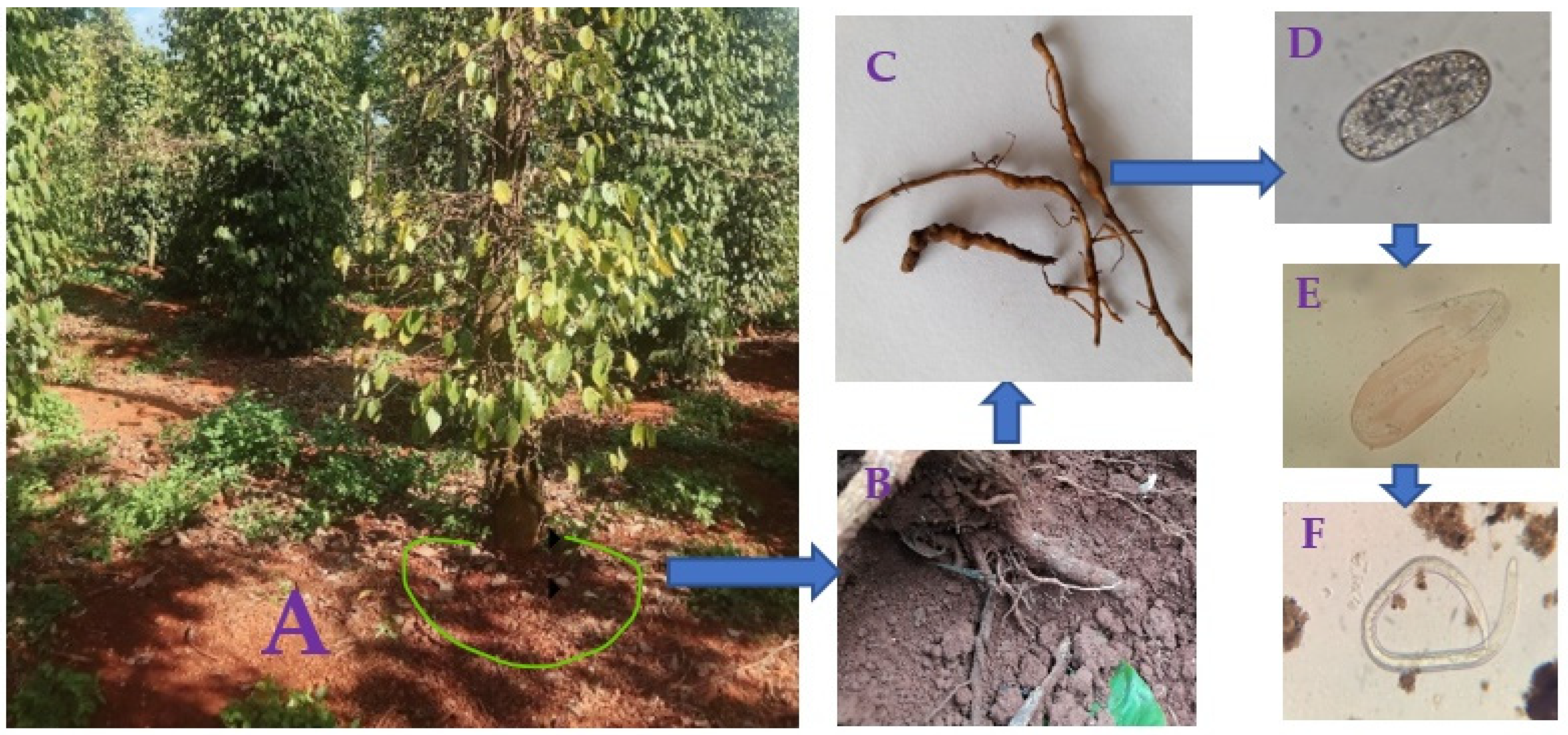
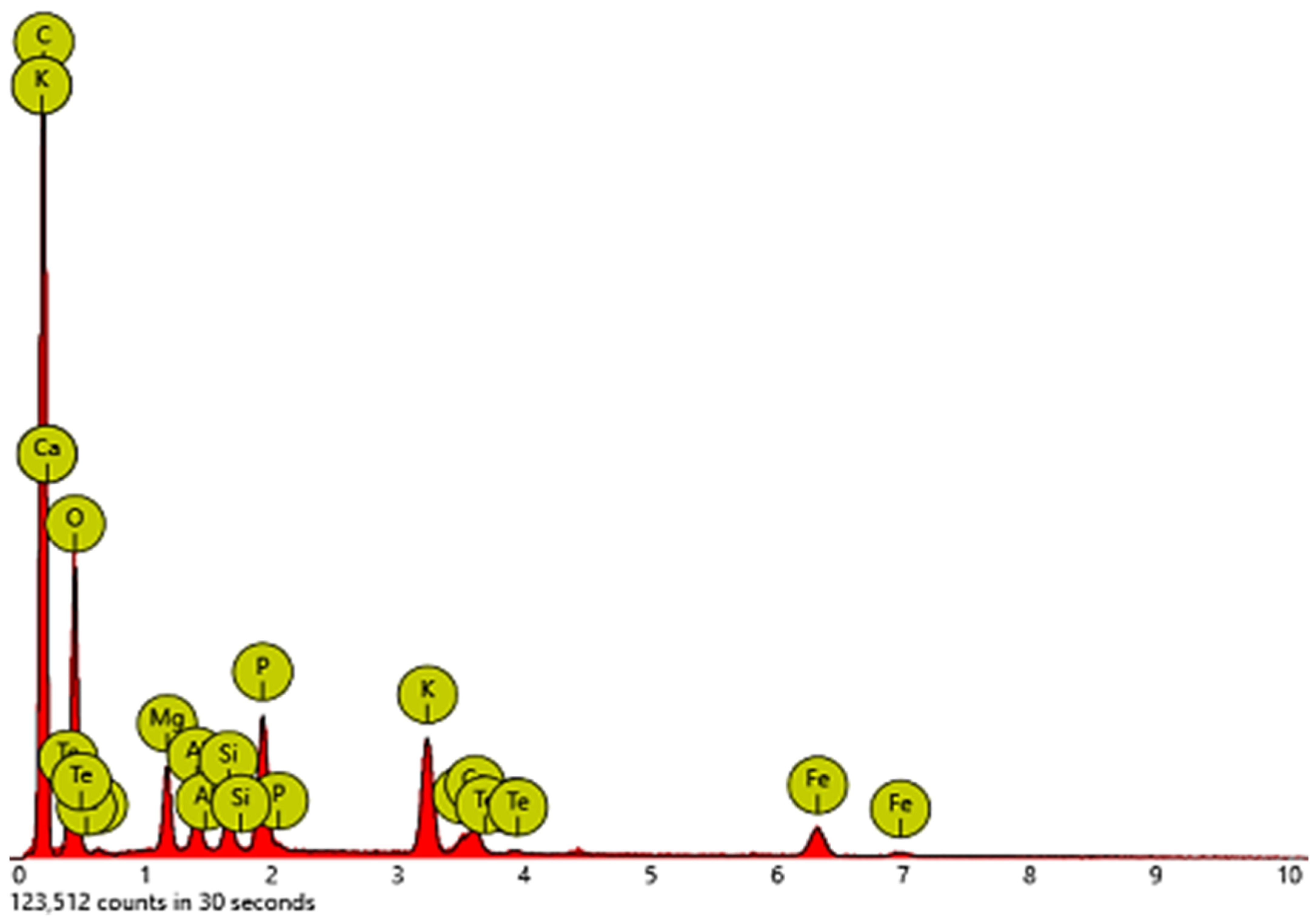
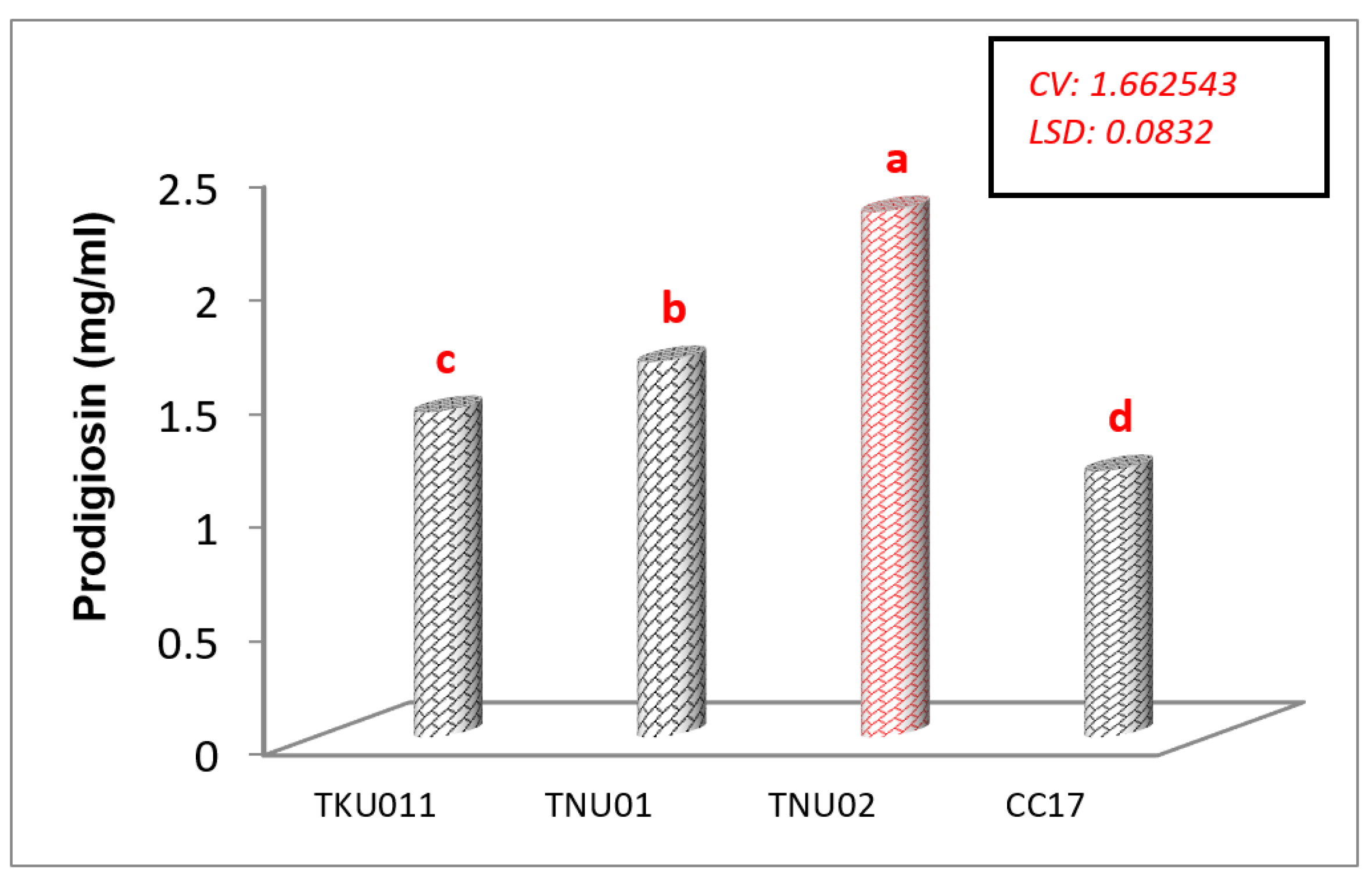
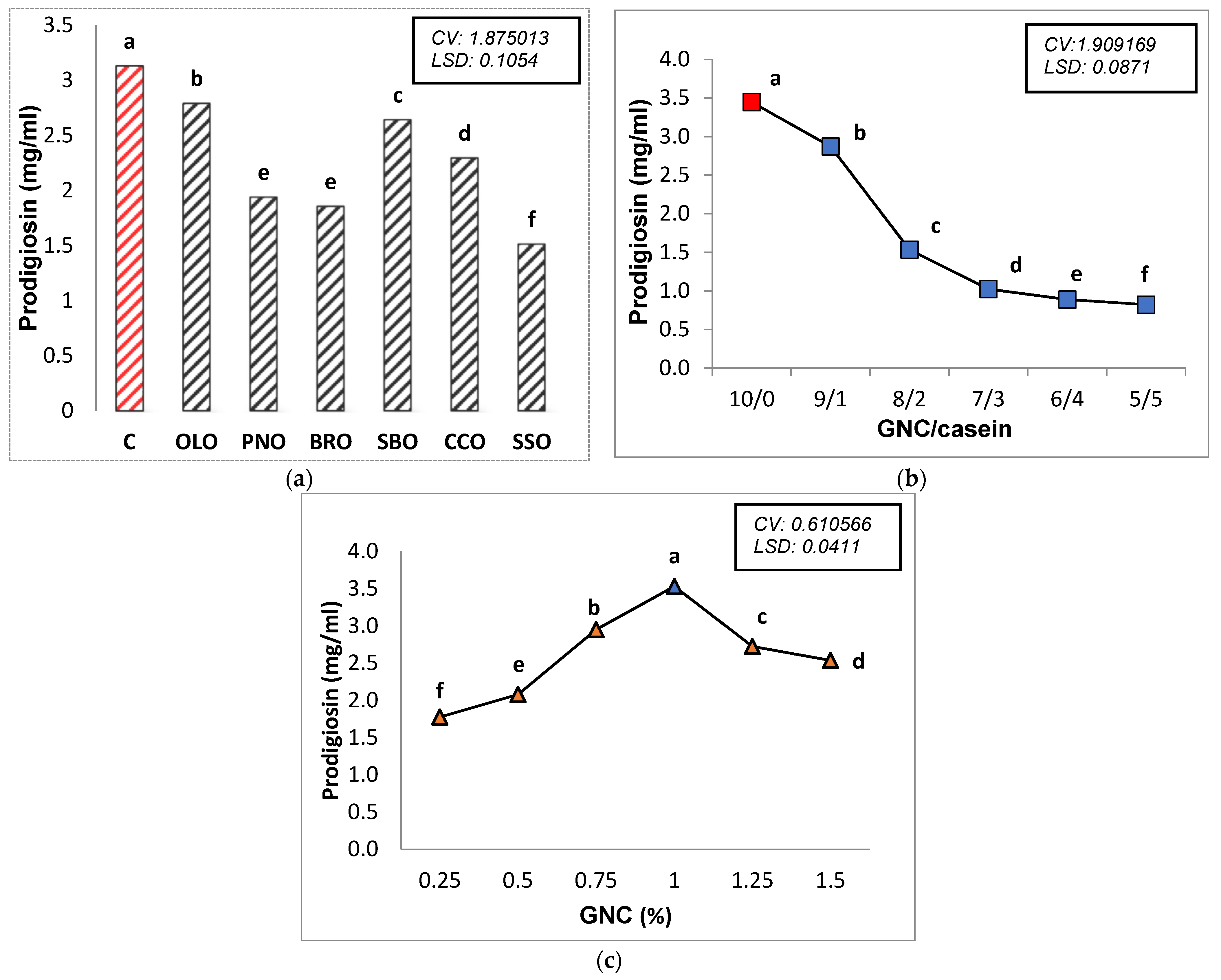

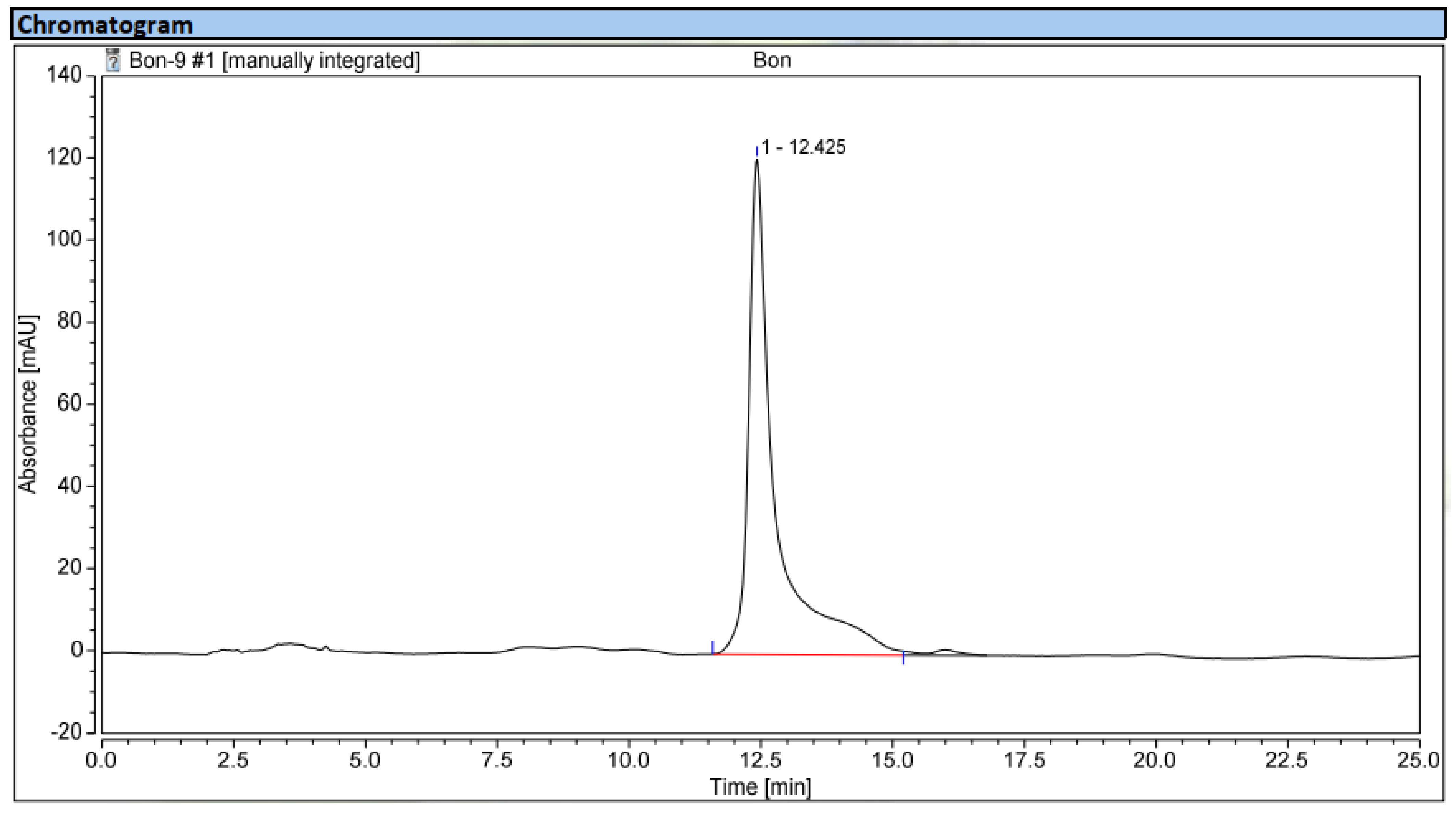

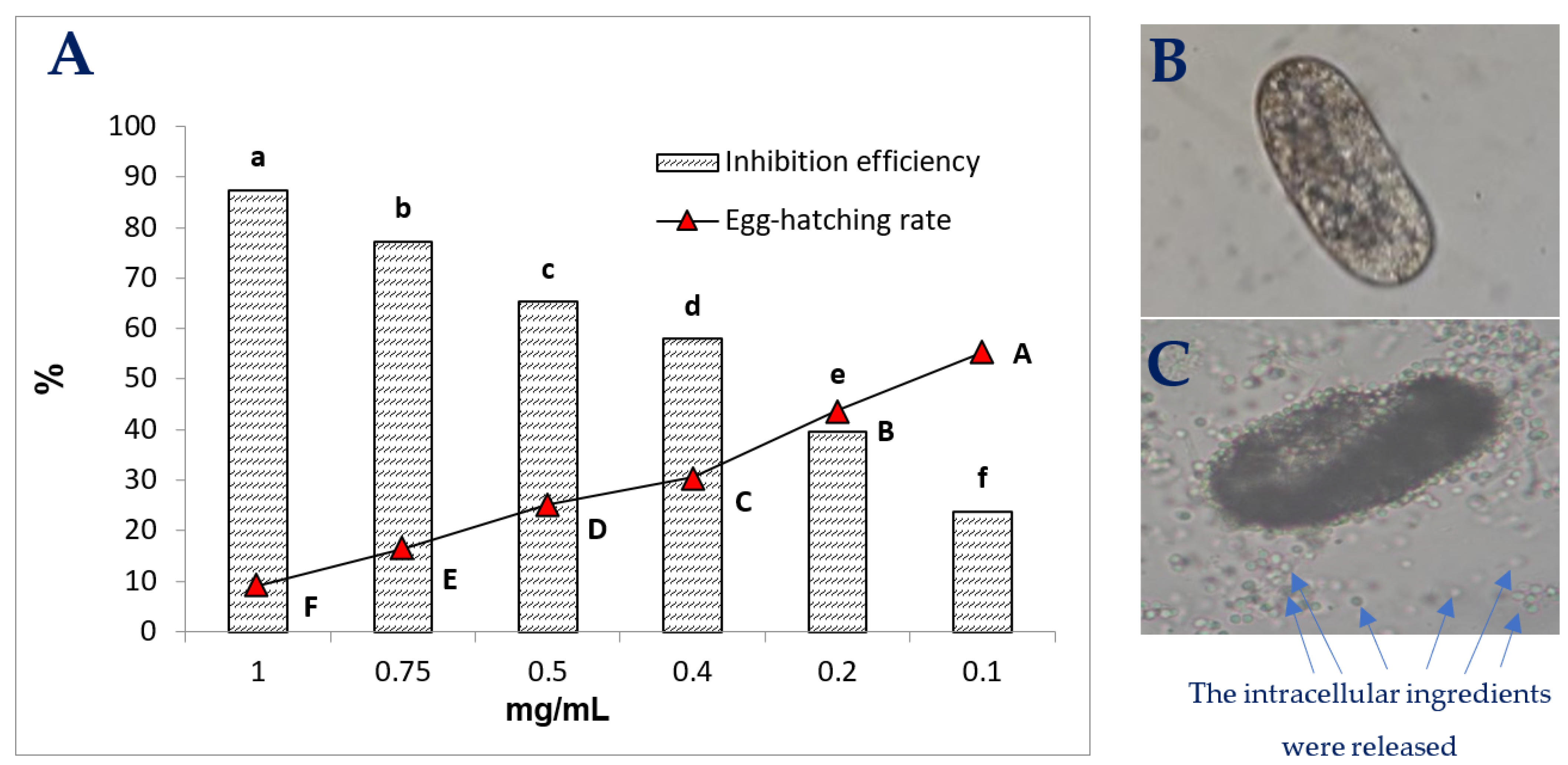
| Content (%) | ||||||||
|---|---|---|---|---|---|---|---|---|
| Protein | Lipid | Total Ash | Total Sugar | Reducing Sugar | Ca | Mg | K | P |
| 36.01 | 9.74 | 12.02 | 2.44 | 0.62 | 0.11 | 0.18 | 0.69 | 0.38 |
| Prodigiosin (mg/mL) | |||
|---|---|---|---|
| Sulfate | Phosphate | ||
| No salts | 5.38 ± 0.034 a | No salts | 5.38 ± 0.034 a |
| No-sulfate | 2.12 ± 0.012 e | No-phosphate | 2.67± 0.073 d |
| (NH4)2SO4 | 3.32 ± 0.01 c | K2HPO4 | 3.42 ± 0.01 c |
| K2SO4 | 3.02 ± 0.008 d | KH2PO4 | 1.89 ± 0.002 e |
| FeSO4 | 1.94 ± 0.017 f | NaH2PO4 | 1.41 ± 0.012 f |
| ZnSO4 | 0.59 ± 0.015 g | Na2HPO4 | 1.94 ± 0.01 e |
| MgSO4 | 3.37 ± 0.005 b | Ca3(PO4)2 | 4.04 ± 0.002 b |
| CV: 0.504726LSD: 0.0355 | CV: 1.407352LSD: 0.1041 | ||
| Production Bacteria | Main Substrate | Supplement Ingredients | Prodigiosin (mg/L) | References |
|---|---|---|---|---|
| S. marcescens TNU02 | 1% groundnut cake | None | 5380 | In this study |
| S. marcescens CF-53 | 8% groundnut cake | None | 39,800 | [14] |
| S.marcescens ATCC 13880 | 4% groundnut cake | 2% sucrose | 900 | [21] |
| S. marcescens TNU02 | Demineralized crab shell powder (de-CSP) | 1.6% (de-CSP/casein:7/3), 0.02% (NH4)2SO4, 0.1% K2HPO4 | 4510 | [25] |
| S. marcescens TKU011 | 1.5% squid pen | 0.1% K2HPO4, 0.05% MgSO4 | 978 | [27] |
| S. marcescens CC17 | Shrimp head powder (SHP) | 1.5% (SHP/casein:9/1), 0.02% K2SO4, 0.025% Ca3(PO4)2 | 5355 | [2] |
| S. marcescens TNU01 | Demineralized shrimp shell powder (de-SSP) | 1.6% (de-SSP/casein:7/3), 0.02% K2SO4, 0.05% K2HPO4 | 5910 | [5] |
| S.marcescens TNU01 | 1.75% squid pens powder | 0.03% K2HPO4, 0.05% MgSO4 | 3790 | [26] |
| S. marcescens TNU01 | Cassava wastewater | 0.25% casein, 0.05% MgSO4, 0.1% K2HPO4 | 5202 | [1] |
| PG-Producing Bacterial Strain | Reactor Size (L) | Fermentation Time (h) | Prodigiosin (mg/L) | References |
|---|---|---|---|---|
| S. marcescens TNU02 | 4 | 10 | 6886 | This study |
| S. marcescens TNU01 | 3–7 | 12 | 3450 | [1,5,26] |
| S. marcescens TNU02 | 4.5 | 8 | 5100 | [25] |
| S. marcescens CC17 | 6.75 | 8 | 6310 | [2] |
| S. marcescens BS 303 (ATCC® 13880TM) | 0.935 | 65 | 872 | [48] |
| S. marcescens | 6.5 | 52 | 595 | [28] |
| S. marcescens 02 | 2.75 | 20 | 583 | [46] |
| Chryseobacterium artocarpi CECT 849 | 50 | 24 | 522 | [47] |
| S. marcescens | 3 | 30 | 50 | [45] |
Publisher’s Note: MDPI stays neutral with regard to jurisdictional claims in published maps and institutional affiliations. |
© 2021 by the authors. Licensee MDPI, Basel, Switzerland. This article is an open access article distributed under the terms and conditions of the Creative Commons Attribution (CC BY) license (https://creativecommons.org/licenses/by/4.0/).
Share and Cite
Nguyen, T.H.; Wang, S.-L.; Doan, M.D.; Nguyen, T.H.; Tran, T.H.T.; Tran, T.N.; Doan, C.T.; Ngo, V.A.; Ho, N.D.; Do, V.C.; et al. Utilization of By-Product of Groundnut Oil Processing for Production of Prodigiosin by Microbial Fermentation and Its Novel Potent Anti-Nematodes Effect. Agronomy 2022, 12, 41. https://doi.org/10.3390/agronomy12010041
Nguyen TH, Wang S-L, Doan MD, Nguyen TH, Tran THT, Tran TN, Doan CT, Ngo VA, Ho ND, Do VC, et al. Utilization of By-Product of Groundnut Oil Processing for Production of Prodigiosin by Microbial Fermentation and Its Novel Potent Anti-Nematodes Effect. Agronomy. 2022; 12(1):41. https://doi.org/10.3390/agronomy12010041
Chicago/Turabian StyleNguyen, Thi Hanh, San-Lang Wang, Manh Dung Doan, Thi Huyen Nguyen, Thi Ha Trang Tran, Thi Ngoc Tran, Chien Thang Doan, Van Anh Ngo, Nhat Duoc Ho, Van Chung Do, and et al. 2022. "Utilization of By-Product of Groundnut Oil Processing for Production of Prodigiosin by Microbial Fermentation and Its Novel Potent Anti-Nematodes Effect" Agronomy 12, no. 1: 41. https://doi.org/10.3390/agronomy12010041










